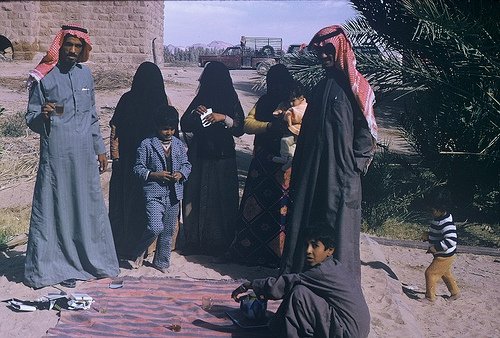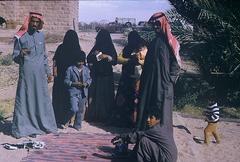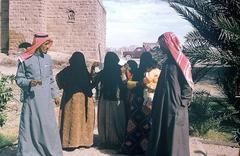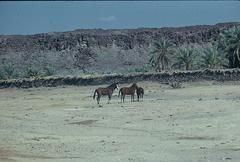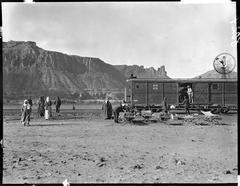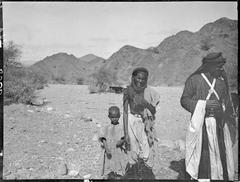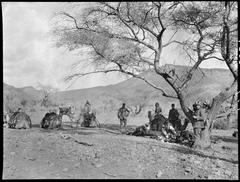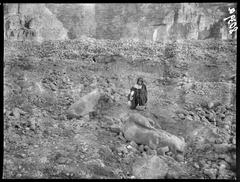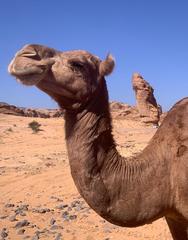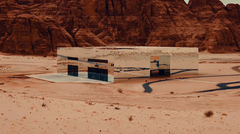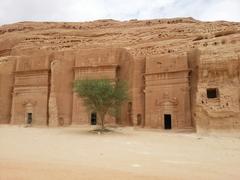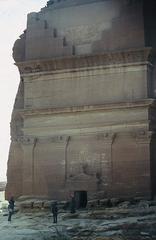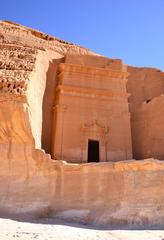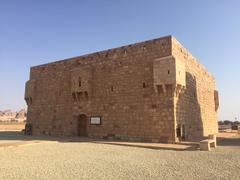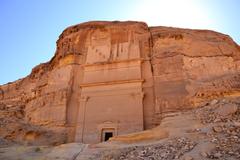Al-Ula Visiting Hours, Tickets, and Historical Sites Guide
Date: 14/06/2025
Introduction to Al-Ula and Its Significance
Al-Ula, located in the Medina Province of northwestern Saudi Arabia, stands as a breathtaking gateway to the ancient world. Renowned for its extraordinary convergence of history, culture, and nature, this desert oasis is home to remarkable archaeological treasures, including the Nabataean city of Hegra—Saudi Arabia’s first UNESCO World Heritage Site. Al-Ula invites visitors to immerse themselves in over 7,000 years of human civilization, from the monumental tombs of Hegra and the lion-guarded necropolis of Dadan to the winding alleys of Al-Ula Old Town. This region is not only a living museum at the crossroads of ancient trade routes but also a testament to the rise and legacy of powerful kingdoms and the enduring spirit of the Arabian Peninsula (Discover Al-Ula; Must-See Al-Ula Historical Sites; Exploring Al-Ula).
Al-Ula welcomes visitors year-round with well-organized access, including daily visiting hours (typically 8:00 AM to 6:00 PM), guided tour options, combination passes, and a commitment to accessibility, featuring wheelchair-friendly paths and inclusive services. The Royal Commission for AlUla has initiated a $15 billion masterplan, balancing sustainable tourism and heritage conservation to ensure the oasis remains vibrant for generations (Discover Al-Ula; Al-Ula Visitor Guide).
Beyond its archaeological gems, Al-Ula’s dramatic landscape—highlighted by Elephant Rock, the stone pillars of Al Gharameel, and volcanic plateaus—offers adventure and serenity. Seasonal festivals such as Winter at Tantora, bustling markets, and immersive agricultural experiences in the palm groves provide rich cultural encounters (Exploring Al-Ula; Must-See Al-Ula Historical Sites).
This comprehensive guide will equip you with essential insights into Al-Ula’s visiting hours, ticketing, historical context, cultural etiquette, and top attractions, empowering you to enjoy a respectful and memorable journey through one of Saudi Arabia’s most treasured destinations.
Table of Contents
- Introduction
- Visiting Hours, Tickets, and Accessibility
- Historical and Archaeological Significance
- Archaeological Timeline
- Preservation and Modern Archaeology
- Key Sites of Archaeological Interest
- Cultural and Religious Significance
- Visitor Experience and Interpretation
- FAQ
- Must-See Al-Ula Historical Sites
- Exploring Al-Ula’s Natural Wonders
- Al-Ula Visitor Guide: Culture, Etiquette, and Travel Tips
- Summary and Visitor Recommendations
- References and Further Reading
Visiting Hours, Tickets, and Accessibility
Al-Ula’s main archaeological sites, such as Hegra and Dadan, are open daily from 8:00 AM to 6:00 PM, with extended hours during peak seasons. Tickets can be purchased online via the official Experience Al-Ula website or at on-site visitor centers. Guided tours and combination passes are available, offering access to multiple attractions.
The region prioritizes accessibility, providing wheelchair-friendly paths, assistive services, and multilingual guides. Early booking is recommended, particularly during festivals and high season.
Historical and Archaeological Significance
Ancient Civilizations and Trade Routes
Al-Ula’s location made it a vital hub connecting the Arabian Peninsula with the Levant, Egypt, and Mesopotamia. As a major stop along the Incense Route, it facilitated trade in spices, incense, and luxury goods between South Arabia and the Mediterranean. Excavations reveal over 7,000 years of continuous human settlement, supported by fertile valleys and water resources (intosaudia.com).
Dadanite and Lihyanite Kingdoms
Before the Nabataeans, Al-Ula was the seat of the Dadanite and Lihyanite kingdoms (9th–2nd centuries BCE). The ancient city of Dadan boasts monumental tombs, inscriptions in ancient scripts, and advanced irrigation systems (welcomesaudi.com). The distinctive lion sculptures on the tombs symbolize strength and guardianship.
Nabataean Era and Hegra (Mada’in Saleh)
The Nabataeans established Hegra as their southernmost city in the 1st century BCE. Now a UNESCO World Heritage Site, Hegra is famed for its 130+ rock-cut tombs, intricate facades, and sophisticated water management systems. The Qasr al-Farid tomb is particularly iconic (blog.almosafer.com).
Al-Ula Old Town
Al-Ula Old Town, inhabited from the 12th century CE until the late 20th century, is a network of mud-brick houses, narrow alleys, and bustling markets. It played a pivotal role for pilgrims journeying to Mecca (saudivisa.ae). The Musa Bin Nusayr Castle offers panoramic views of the oasis (blog.almosafer.com).
The Hijaz Railway
Built by the Ottomans in the early 20th century, the Hijaz Railway linked Damascus to Medina, passing through Al-Ula. Remnants of stations and tracks are still visible, adding a modern historical layer to the region (setupinsaudi.com).
Petroglyphs and Rock Art
Al-Ula’s sandstone cliffs are adorned with thousands of petroglyphs and inscriptions, depicting animals, hunting scenes, and ancient scripts. These artworks span millennia and reflect Al-Ula’s significance as a cultural crossroads (intosaudia.com).
Archaeological Timeline
- Prehistoric Era (c. 5000 BCE and earlier): Earliest settlements, stone tools, rock art.
- Dadanite Kingdom (9th–6th centuries BCE): Monumental tombs, urban development.
- Lihyanite Kingdom (6th–2nd centuries BCE): Expansion, lion tombs, irrigation.
- Nabataean Period (1st century BCE–1st century CE): Hegra’s rise, trade prosperity.
- Roman and Early Islamic Periods (2nd–10th centuries CE): Continued settlement and integration.
- Medieval to Modern Era (12th–20th centuries CE): Growth of Old Town, Hijaz Railway (intosaudia.com).
Preservation and Modern Archaeology
Al-Ula’s dry climate has helped preserve its heritage. The Royal Commission for AlUla (RCU) leads a $15 billion “Journey Through Time Masterplan” to conserve, research, and develop Al-Ula as a global heritage and tourism destination (welcomesaudi.com). International archaeological teams continue to unveil tombs and artifacts, deepening our understanding of the region’s layered history.
Key Sites of Archaeological Interest
- Hegra (Mada’in Saleh): Over 130 Nabataean tombs, Qasr al-Farid, Jabal Ithlib.
- Dadan: Lion Tombs, ancient stairways, inscriptions.
- Al-Ula Old Town: Mud-brick dwellings, Musa Bin Nusayr Castle.
- Elephant Rock: Iconic sandstone formation (blog.almosafer.com).
- Hijaz Railway Station: Ottoman-era relics.
Cultural and Religious Significance
Al-Ula is associated with the ancient Thamudic people, referenced in the Quran through the story of Prophet Salih. The ruins at Hegra are traditionally linked to the Thamud, adding religious resonance for Muslim visitors (welcomesaudi.com).
Visitor Experience and Interpretation
Visitors benefit from guided tours, interpretive signage, interactive museums, and digital resources. These elements provide educational context while balancing preservation and accessibility (experiencealula.com). Photographers will find countless scenic spots, especially at Hegra’s tombs and Elephant Rock.
FAQ
What are Al-Ula’s visiting hours?
Most sites are open daily from 8:00 AM to 6:00 PM, with seasonal variations.
How can I buy tickets?
Purchase online at the Experience Al-Ula website or at visitor centers.
Are guided tours available?
Yes, in multiple languages. Book online or onsite.
Is Al-Ula accessible for people with disabilities?
Yes, accessible paths and services are available.
What should I bring?
Comfortable shoes, sun protection, water, and a camera.
Are there nearby accommodations?
Yes, a growing range of hotels and resorts are available.
Numbers and Facts
- Hegra: Over 130 tombs from the 1st century BCE–1st century CE.
- Old Town: About 900 houses, 400 shops.
- Dadan: Dozens of monumental tombs, hundreds of inscriptions.
- Tourism Development: $15 billion project, 7,500 hotel keys, 5,000 residential units (setupinsaudi.com).
Plan Your Visit
Experience the wonders of Al-Ula. For the latest updates, tickets, and exclusive offers, download the Audiala app and follow our social channels. Explore related articles to enrich your journey in Saudi Arabia.
Alt Text Suggestions for Visuals:
- Panoramic view of Hegra’s tombs at sunset
- Lion sculptures of Dadan tombs
- Al-Ula Old Town’s mud-brick alleys
- Elephant Rock against a blue sky
- The restored Hijaz Railway station
Must-See Al-Ula Historical Sites: Visiting Hours, Tickets & Top Attractions
Hegra (Mada’in Saleh): Saudi Arabia’s First UNESCO World Heritage Site
Hegra, the southernmost Nabataean city, is Saudi Arabia’s first UNESCO World Heritage Site. Located 22 km north of Al-Ula, it features over 110 monumental tombs carved into rose sandstone. Don’t miss Qasr al-Farid (“The Lonely Castle”) and Qasr al-Bint.
- Visiting Hours: 8:00 AM–5:00 PM (last entry 4:00 PM)
- Tickets: SAR 95 (~$25), online or at the visitor center; guided tours are mandatory
- Best Time: October–April for cooler weather
(Experience AlUla)
Al-Ula Old Town: A Living Time Capsule
This maze of 900 mudbrick houses and 400 shops was a bustling stop for pilgrims until the 1980s.
- Hours: Sunrise to sunset; no entry fee
- Tips: Take a guided tour, visit the Jumma Mosque, and climb Musa Bin Nusayr Citadel for views
Dadan and the Lion Tombs
Once the Dadanite and Lihyanite capital, Dadan is known for rock-cut lion tombs.
- Hours: 8:00 AM–5:00 PM; tickets via Experience AlUla
- Tips: Walk the Heritage Trail; guided tours recommended
Jabal Ikmah: The Open-Air Library
A canyon with hundreds of ancient inscriptions.
- Hours: 8:00 AM–5:00 PM; access by guided tour only
Elephant Rock (Jabal AlFil): Nature’s Masterpiece
A 52-meter-tall natural rock formation, best at sunset.
- Open: Year-round
- Facilities: Seating, food trucks, live events
Maraya Concert Hall: A Modern Marvel
The world’s largest mirrored building, hosting concerts and exhibitions.
- Access: Exterior open daily; tickets required for events
Al Gharameel: The Dancing Rocks
Slender stone pillars perfect for stargazing.
- Best Visited: Sunset/night; guided tours available
Jabal Ithlib and Al Diwan
Nabataean ritual spaces with rock carvings and ceremonial chambers.
- Hours: 8:00 AM–5:00 PM; guided tours recommended
Hijaz Railway Station
A restored Ottoman-era railway station with historical displays.
- Access: During heritage tours; check schedule
AlUla Fresh (Mazaq) and Oasis Experiences
Tour palm groves, taste dates, and enjoy farm-to-table meals.
- Open: Daily; some activities require booking
Outdoor Adventure
Hike the Dadan Heritage Trail, climb rock formations, or stargaze at Al Gharameel.
Practical Tips for Visiting Al-Ula Historical Sites
- Transportation: Rent a car or arrange taxis; sites are spread out
- Guided Tours: Required at most sites; book via Experience AlUla
- Best Time: October–April
- Dress Code: Modest attire; ask before photographing people
- Health: Bring water, sun protection, and any medications
Exploring Al-Ula: Natural Wonders and Outdoor Activities
The Oasis and Its Contrasts
Al-Ula’s lush oasis contrasts dramatically with its surrounding sandstone cliffs, canyons, and volcanic plateaus, forming a unique landscape central to millennia of settlement (Wikipedia).
Iconic Rock Formations
- Elephant Rock: A 52-meter sandstone “elephant,” vibrant at sunset (OutdoorKeeda).
- Al Gharameel: Pillars ideal for night sky photography and stargazing.
- Harrat Uwayrid: Volcanic plateau with panoramic views and wildlife.
Canyons and Wadis
Wadis like Wadi Al-Qura have supported settlement since at least 5000 BCE, featuring dramatic cliffs and hidden caves (Wikipedia).
Outdoor Activities
- Hiking and Trekking: From palm groves to volcanic plateaus; guided hikes available
- Hot Air Balloon Rides: Experiencing sunrise over Al-Ula is a highlight during festivals (OutdoorKeeda)
- Rock Climbing & Adventure Sports: Sandstone cliffs offer climbing, ziplining, and abseiling (Postcards from the World)
- Cycling & Horseback Riding: Scenic rides through desert and oasis
- Stargazing: Minimal light pollution; organized events at Al Gharameel (OutdoorKeeda)
Oasis Experience
Tour date farms, sample locally grown fruit, and learn about traditional irrigation (OutdoorKeeda).
Dining
Enjoy picnics and traditional meals in the desert, with dishes like lamb mandi and Arabic coffee (OutdoorKeeda).
Visitor Information
- Tickets: Purchase online (Royal Commission for Al-Ula) or at site entrances
- Accessibility: Many sites are wheelchair-friendly; check latest Covid-19 protocols
- Transportation: Renting a car recommended; guided tours and taxis available (Postcards from the World)
- Packing: Layered clothing, sun protection, sturdy shoes, water
- Eco-Responsibility: Follow Leave No Trace principles
Unique Experiences
- Al-Ula Moments Festival: Hot air balloons, concerts, art, adventure sports (OutdoorKeeda)
- Photography: Breathtaking light and unique geology at sunrise/sunset
Al-Ula Visitor Guide: Cultural Insights, Etiquette, and Travel Tips
Cultural Etiquette
- Hospitality: Accepting coffee and dates is polite (Intosaudia; Airlink Hajj and Umrah)
- Religion: Respect prayer times; non-Muslims may not enter mosques (Intosaudia)
- Dress: Modest clothing; women may wear an abaya, and a headscarf is recommended for religious sites (Intosaudia)
- Communication: Greet with “As-salamu alaykum”; avoid sensitive topics
- Dining: Eat with the right hand, no alcohol (David Travels)
- Legal: Carry ID, avoid public displays of affection (Intosaudia; David Travels)
Festivals and Souvenirs
- Winter at Tantora: Music, arts, and international performances (Travel Pander)
- Crafts: Pottery, weaving, jewelry; try workshops and shop in markets
Travel Tips
- Carry passport/visa copies
- Plan around prayer times
- Download the Al-Ula app for maps, bookings, and event info
Summary and Visitor Recommendations
Al-Ula seamlessly blends ancient history, dramatic landscapes, and living heritage. From the awe-inspiring tombs of Hegra and the lion-guarded necropolis of Dadan to the lush oasis and contemporary wonders like Maraya Concert Hall, the region offers a multifaceted, enriching experience (Discover Al-Ula; Must-See Al-Ula Historical Sites; Al-Ula Visitor Guide).
Careful planning—regarding hours, tickets, and cultural etiquette—ensures a smooth, rewarding visit. The Royal Commission for AlUla’s commitment to sustainable tourism safeguards both the archaeological treasures and the visitor experience (Discover Al-Ula).
Explore Al-Ula’s timeless stories and breathtaking beauty using the official website, mobile app, and social media channels for updates, events, and tips. Start your journey and discover why Al-Ula is one of the world’s most extraordinary archaeological and natural destinations (Discover Al-Ula; Exploring Al-Ula; Al-Ula Visitor Guide).
References and Further Reading
- Discover Al-Ula: Visiting Hours, Tickets, and Exploring Saudi Arabia’s Ancient Oasis, Experience Al-Ula (https://www.experiencealula.com)
- Must-See Al-Ula Historical Sites: Visiting Hours, Tickets & Top Attractions in Saudi Arabia, Experience Al-Ula (https://www.experiencealula.com/en)
- Exploring Al-Ula: Visiting Hours, Tickets, and Outdoor Activities at Saudi Arabia’s Natural Wonder, OutdoorKeeda (https://www.outdoorkeeda.com/al-ula-4615.html)
- Al-Ula Visitor Guide: Cultural Insights, Etiquette, and Travel Tips, Intosaudia (https://intosaudia.com/essential-guide-to-saudi-culture-visitor-etiquette/)
- Airlink Hajj and Umrah Travel Tips
- David Travels Etiquette Rules
- Travel Pander Al-Ula Guide
